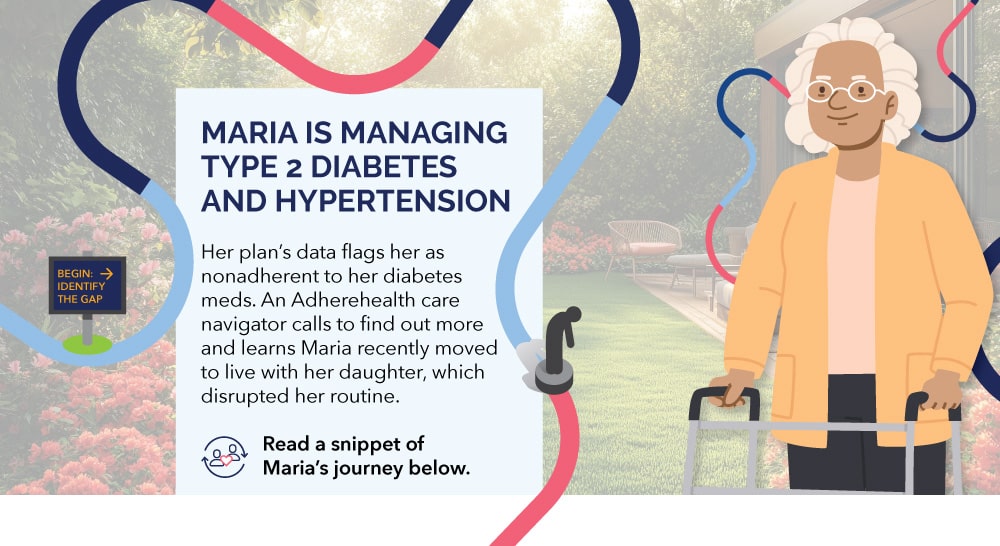Published on .
In the world of Medicare Advantage (MA), medication adherence is the workhorse for strong Star Ratings performance. It’s closely tied to member health, cost containment and overall plan value. The three triple-weighted Part D adherence measures—for RAS antagonists, statins and diabetes medications—carry significant influence on a plan’s Star Ratings performance.
A sustained focus on adherence is what drives long-term success. Year-over-year engagement helps members stay on track—and keeps performance strong. While it’s important to focus on the direct (and indirect) impact of adherence measures on total Stars scoring, plans have opportunities to amplify efforts with complementary strategies like “companion measures”—delivering an even bigger impact on Star Ratings.
Adding companion measures to your Stars strategy is a smart, strategic way to maximize performance by connecting the dots between medication adherence and the many related metrics that also influence quality scores and member health. Rather than treating adherence as a standalone campaign, plans can use it as an entry point for whole-person engagement.
The triple pillars of adherence
CMS originally prioritized the three Part D adherence measures due to the high clinical impact of managing diabetes, high cholesterol and hypertension, and strong evidence linking medication adherence to improved health. These measures have carried triple weight because of their significant influence on member health and Stars performance.
For MY 2026, CMS will temporarily reduce the weighting of these measures to 1x to accommodate sociodemographic status (SDS) risk adjustments. However, this change doesn’t diminish the importance of adherence within the Stars framework. In fact, maintaining strong adherence during this period is critical. The members who are engaged and adherent now are more likely to stay that way when the triple weighting returns in MY 2027—and by incorporating companion measures during this window, plans can strengthen performance across a broader range of metrics while reinforcing year-over-year engagement.
What are adherence “companion measures”?
This is a term used by AdhereHealth to denote Star Ratings metrics closely related to adherence—either because they address the same conditions or because they reflect the same member behaviors and barriers. For this reason, companion measures can often be addressed in the same outreach conversation. For example, if a care navigator is calling a member about a missed refill for their diabetes medication, this is a natural time to also check on the member’s A1C testing, eye exam or kidney screening.
The concept of companion measures helps outreach teams work smarter, not harder. Instead of separate outreach efforts for every quality metric, care navigators can bundle multiple priorities into a single, meaningful interaction—helping to reduce member abrasion and improve efficiency. Most importantly, this process drives better outcomes across multiple fronts.
Why adherence and companion measures should be tackled together
Bundling isn’t just convenient—it’s strategic.
Members who are nonadherent often show patterns that cut across multiple clinical areas. For example, someone who skips their statin may also be behind on their blood pressure checks or reluctant to go in for labs. Plus, social or behavioral barriers affecting adherence—like low health literacy, limited transportation or conflicting priorities—will likely also impact other areas of the member’s life. Once a plan resolves these challenges, it can improve measure performance across the board.
That’s why addressing companion measures alongside medication adherence just makes sense. It creates a fuller picture of member needs and reinforces a whole-person approach to care. Plus, it makes better use of limited time and resources, helping address physician burnout and the ongoing provider shortage now well-recognized in the healthcare industry. One well-structured outreach call can move the needle on several measures.
From a Star Ratings perspective, it’s a multiplier. As adherence temporarily loses its triple-weighted punch, boosting performance on related Part C measures helps balance the scales and preserve overall ratings.
Whole-person engagement in action
Let’s take Maria, a 72-year-old Medicare Advantage member managing type 2 diabetes and hypertension.
Her plan’s data flags her as nonadherent to her diabetes meds. A care navigator calls to find out more and learns Maria recently moved to live with her daughter, which disrupted her routine. During the conversation, the navigator checks to see when Maria last had labs drawn and confirms it’s been over a year; there’s also no eye exam on file.
The care navigator helps Maria get her meds refilled, coordinates with her primary care provider for a lab order and facilitates a doctor visit for an eye exam. In one call, the health plan was able to tackle three quality measures and forge a clearer path to improved health. That’s the power of companion measures.
The road ahead: making the most of every outreach
Medication adherence isn’t a one-time win—it’s a year-over-year journey that requires consistent, meaningful engagement. Plans that keep adherence at the center of their strategy, even during periods of change, are more likely to build lasting member behaviors that lead to improved outcomes and stronger Star Ratings.
Companion measures offer a practical way to support that journey. By pairing adherence efforts with related metrics, each conversation becomes an opportunity to reinforce adherence while boosting performance in other critical areas.
When medication adherence measures regain their 3x weighting, plans that took the time to build these cross-measure strategies will be in an even stronger position to drive higher Star Ratings performance and better member health.
AdhereHealth helps you improve engagement and adherence, for improved Star Ratings. Contact us to discuss what additional measures will drive your plan’s performance.

Sara Baughn
AdhereHealth Senior Vice President, Business Development


